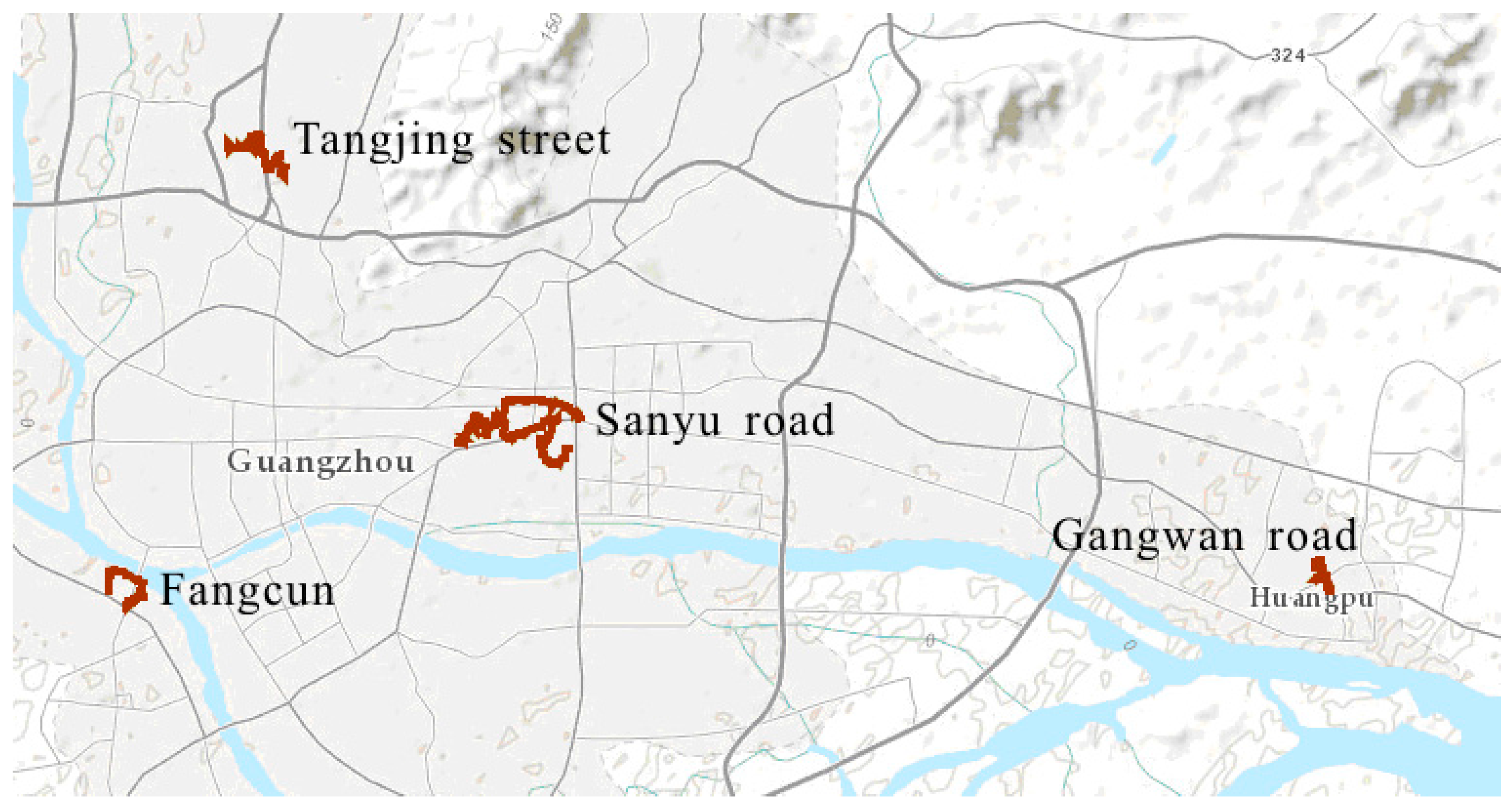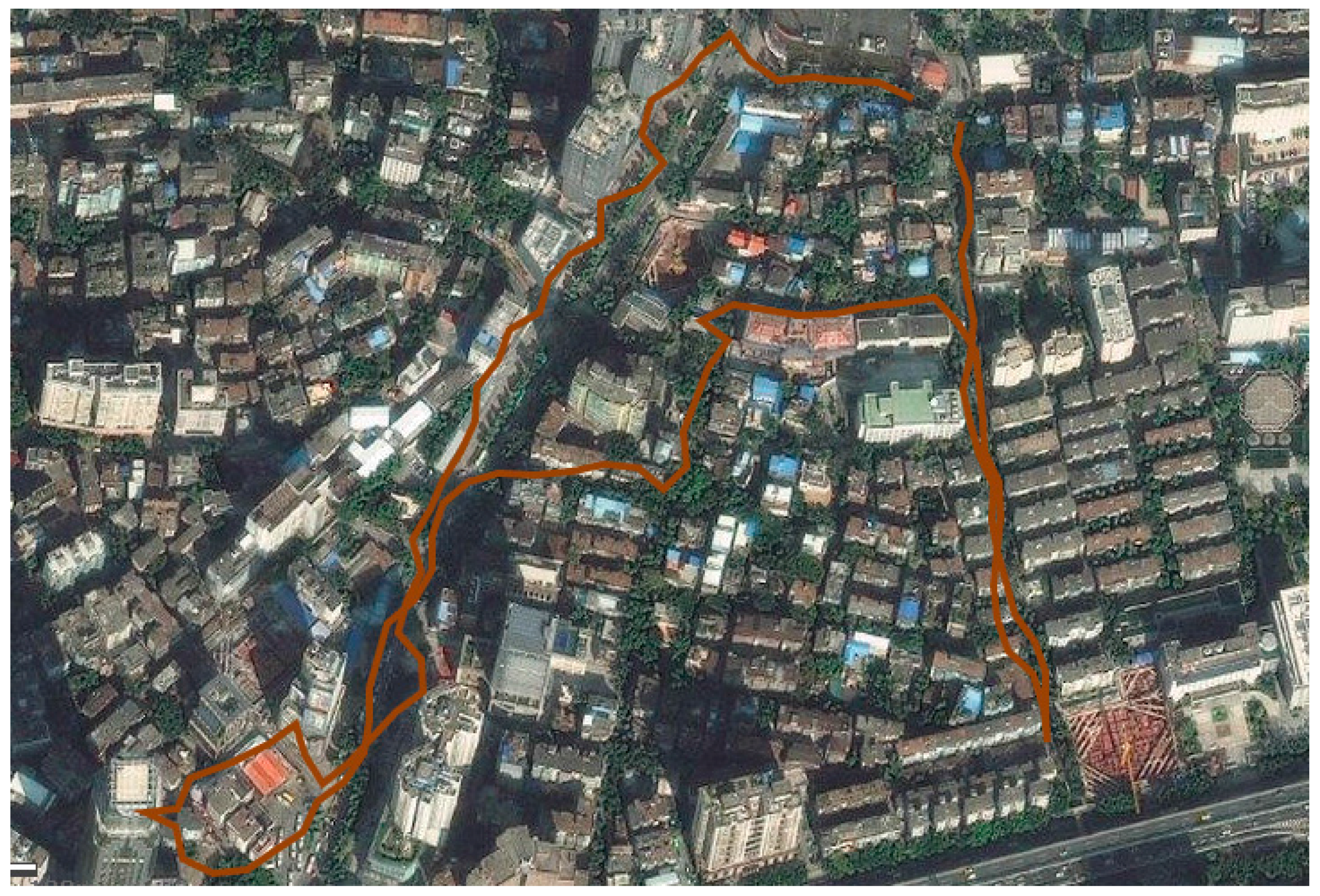Mosquito (Diptera: Culicidae) Habitat Surveillance by Android Mobile Devices in Guangzhou, China
Abstract
:1. Introduction
2. Materials and Methods
3. Results and Discussion
4. Conclusions
Acknowledgments
Author Contributions
Conflicts of Interest
References
- Gubler, D.J.; Reiter, P.; Ebi, K.L.; Yap, W.; Nasci, R.; Patz, J.A. Climate variability and change in the United States: Potential impacts on vector and Rodent-Borne Diseases. Environ. Health Perspect. 2001, 109, 223–233. [Google Scholar] [CrossRef] [PubMed]
- Focks, D.A. A Review of Entomological Sampling Methods and Indicators for Dengue Vectors; World Health Organization: Geneva, Switzerland, 2003. [Google Scholar]
- Song, S.F.; Luo, L.; Jin, Q.L.; Yang, Z.C. Epidemiological analysis of Dengue Fever in Guangzhou, 2001–2010. China Trop. Med. 2012, 12, 214–216. (In Chinese) [Google Scholar]
- Li, B.; Morton, L.C.; Liu, Q.Y. Climate change and mosquito-borne diseases in China: A review. Glob. Health 2013. [Google Scholar] [CrossRef]
- Kline, D.L. Mosquito population surveillance techniques. Tech. Bull. Fla. Mosq. Control Assoc. 2013, 7, 2–8. [Google Scholar]
- Richards, S.L.; Ghosh, S.K.; Zeichner, B.C.; Apperson, C.S. Impact of source reduction on the spatial distribution of larve and pupae of Aedes albopictus (Diptera: Culicidae) in suburban neighborhoods of a Piedmont community in North Carolina. J. Med. Entomol. 2008, 45, 617–628. [Google Scholar] [CrossRef]
- Weaver, J.H.R.; Phillips, J.D.; Gaines, M.K.; Xue, R.D.; Bequette, J.M. Analysis of Anastasia Mosquito Control District service requests. Wing Beats 2013, 24, 34–39. [Google Scholar]
- Mark, T.; Wesley, S.; Yages, S.; Tanya, D.; Mickey, C.; Petrida, I.; Alexander, C.T.; Debra, J. The use of mobile phones as a data collection tool: A report from a household survey in South Africa. BMC Med. Inform. Decis. Mak. 2009. [Google Scholar] [CrossRef]
- Zhang, J.; Li, C.S.; Li, X. Application of Oruxmaps software and android mobile on continuous forest inventory. Sichuan For. Explor. Des. 2012, 74–76, (Special volume in Chinese). [Google Scholar]
- Dai, J.S.; Li, J.; Gu, Z.K.; Sun, B. A research on utility of pedometer to measure walking. J. Beijing Univ. Phys. Educ. 2008, 31, 219–222. (In Chinese) [Google Scholar]
- Wu, T.P.; Wu, F.B.; Bao, J.Y.; Xu, X.T.; Huang, X.; Wang, H.; Liang, J.S.; Liu, G.X. Larval mosquito surveillance in mosquito management areas of Jiangan and Jianghan Districts of Wuhan. Chin. J. Vector Biol. Control 2004, 15, 467–468. (In Chinese) [Google Scholar]
- Xing, W.Z. Application of the flat terminal transmission line geographic information and navigation tracking system. Autom. Appl. 2014, 11, 97–98. (In Chinese) [Google Scholar]
- Wu, T.P.; Hu, Q.; Zhao, T.Y.; Tian, J.H.; Xue, R.D. Morphological studies of Culex molestus of Culex pipiens Complex (Diptera: Culicidae) in underground parking lots in Wuhan, Central China. Fla. Entomol. 2014, 97, 1191–1198. [Google Scholar] [CrossRef]
- Wu, T.P.; Tian, J.H.; Zhao, T.Y.; Chen, X.M.; Xue, R.D. Mosquito Surveillance (Diptera: Culicidae) from Underground Parking Lots in Urban Area in Wuhan, Central China. Entomol. Ornithol. Herpetol. 2015. [Google Scholar] [CrossRef]
- Unlu, I.; Farajollahi, A.; Strickman, D.; Fonseca, D.M. Crouching tiger, hidden trouble: Urban sources of Aedes albopictus (Diptera: Culicidae) refractory to source-reduction. PLoS ONE 2013, 8, e77999. [Google Scholar] [CrossRef] [PubMed]
- Ooi, E.E.; Goh, K.T.; Gubler, D.J. Dengue prevention and 35 years of vector control in Singapore. Emerg. Infect Dis. 2006, 12, 887–893. [Google Scholar] [CrossRef] [PubMed]
- Gubler, D.J. Dengue and Dengue Hemorrhagic Fever. Clin. Microbiol. Rev. 1998, 11, 480–496. [Google Scholar] [PubMed]
- Wu, T.P.; Ma, L.H.; Liang, J.S.; Zhou, L.C.; Chen, X.M.; Liu, Q.; Bao, J.Y.; Tian, J.H. Vector management surveillance in Constructing National Sanitary City of Wuhan. Chin. J. Hyg. Insectic. Equip. 2015, 21, 451–457. (In Chinese) [Google Scholar]
- Luo, L.; Li, X.N.; Xu, Y.; Huang, M.L.; Yang, Z.C. Identification of Aedes albopictus larval index thresholds in the transmission of Dengue in Guangzhou, China. J. Vector Ecol. 2015, 40, 240–246. [Google Scholar] [CrossRef] [PubMed]
- Lozano-Fuentes, S.; Wedyan, F.; Hernandez-Garcia, E.; Sadhu, D.; Ghosh, S.; Bieman, J.M.; Tep-Chel, D.; Garcia-Rejon, J.E.; Eisen, L. Cell Phone-Based System (Chaak) for Surveillance of Immatures of Dengue Virus Mosquito Vectors. J. Med. Entomol. 2013, 50, 879–889. [Google Scholar] [CrossRef] [PubMed]



| Inspecting Site | Length of Route (km) | Elapsed Time (h) |
|---|---|---|
| Sanyu road, Yuexiu District | 6.3 | 3.9 |
| Tangjing street, Baiyun D. | 3.3 | 2.8 |
| Gangwan road, Huangpu D. | 2.2 | 1.6 |
| Fangcun, Liwan D. | 2.8 | 2.1 |
| Total | 14.6 | 10.3 |
| Premise Type | Number of Segments | Number of Mosquito Positive Habitats | CI (%) | RI | TI |
|---|---|---|---|---|---|
| Road and around | |||||
| Roadside | 27 | 44 | 42 | 4.2 | 8.0 |
| Wasteland | 2 | 6 | 50 | 36.5 | 26.8 |
| Subtotal | 29 | 50 | 43 | 4.7 | 8.7 |
| Residential area | |||||
| Old residential area | 7 | 17 | 57 | 31.4 | 22.8 |
| Property management residential area | 1 | 1 | 50 | 30.3 | 3.1 |
| Village in city | 2 | 10 | 50 | 22.7 | 35.3 |
| Subtotal | 9 | 28 | 54 | 27.6 | 20.8 |
| Underground | |||||
| Underground parking lot | 3 | 8 | 100 | 70.9 | 21.3 |
| Metro near the entrance | 2 | 2 | 100 | 50.0 | 30.0 |
| Subtotal | 5 | 10 | 100 | 65.4 | 22.6 |
| Farmer’s market | 3 | 0 | 0 | 0.0 | 0.0 |
| Others | |||||
| Bird and flower market | 1 | 25 | 52 | 121.5 | 101.8 |
| School | 1 | 6 | 67 | 73.8 | 33.9 |
| Driving school | 2 | 7 | 37 | 38.8 | 25.5 |
| Enterprise | 2 | 8 | 67 | 25.8 | 23.8 |
| Park | 2 | 18 | 49 | 19.7 | 19.9 |
| Hospital | 3 | 6 | 38 | 18.4 | 17.9 |
| Hotel | 2 | 8 | 40 | 14.9 | 25.0 |
| Subtotal | 13 | 78 | 48 | 30.6 | 30.1 |
| Total | 60 | 166 | 49 | 11.3 | 16.1 |
© 2016 by the authors; licensee MDPI, Basel, Switzerland. This article is an open access article distributed under the terms and conditions of the Creative Commons Attribution (CC-BY) license (http://creativecommons.org/licenses/by/4.0/).
Share and Cite
Wu, T.-P.; Tian, J.-H.; Xue, R.-D.; Fang, Y.-L.; Zheng, A.-H. Mosquito (Diptera: Culicidae) Habitat Surveillance by Android Mobile Devices in Guangzhou, China. Insects 2016, 7, 79. https://doi.org/10.3390/insects7040079
Wu T-P, Tian J-H, Xue R-D, Fang Y-L, Zheng A-H. Mosquito (Diptera: Culicidae) Habitat Surveillance by Android Mobile Devices in Guangzhou, China. Insects. 2016; 7(4):79. https://doi.org/10.3390/insects7040079
Chicago/Turabian StyleWu, Tai-Ping, Jun-Hua Tian, Rui-De Xue, Yi-Liang Fang, and Ai-Hua Zheng. 2016. "Mosquito (Diptera: Culicidae) Habitat Surveillance by Android Mobile Devices in Guangzhou, China" Insects 7, no. 4: 79. https://doi.org/10.3390/insects7040079






